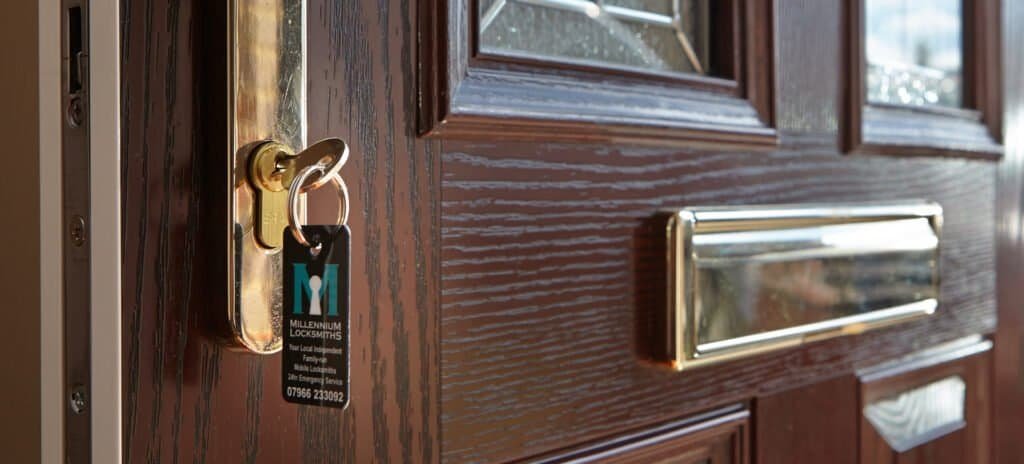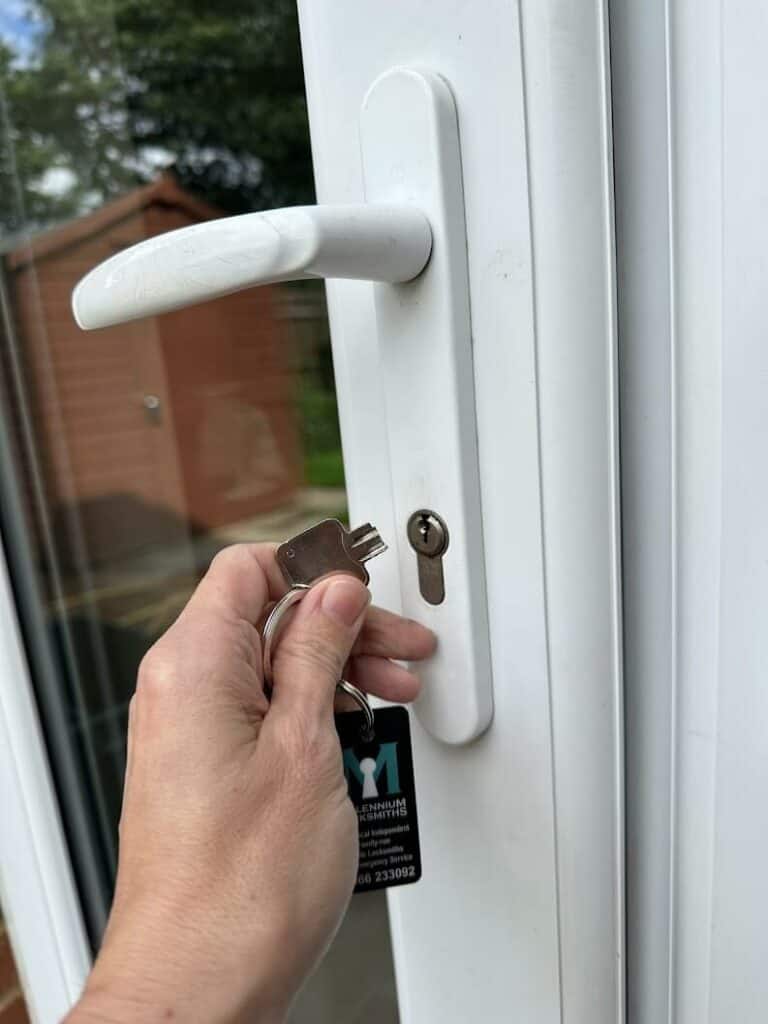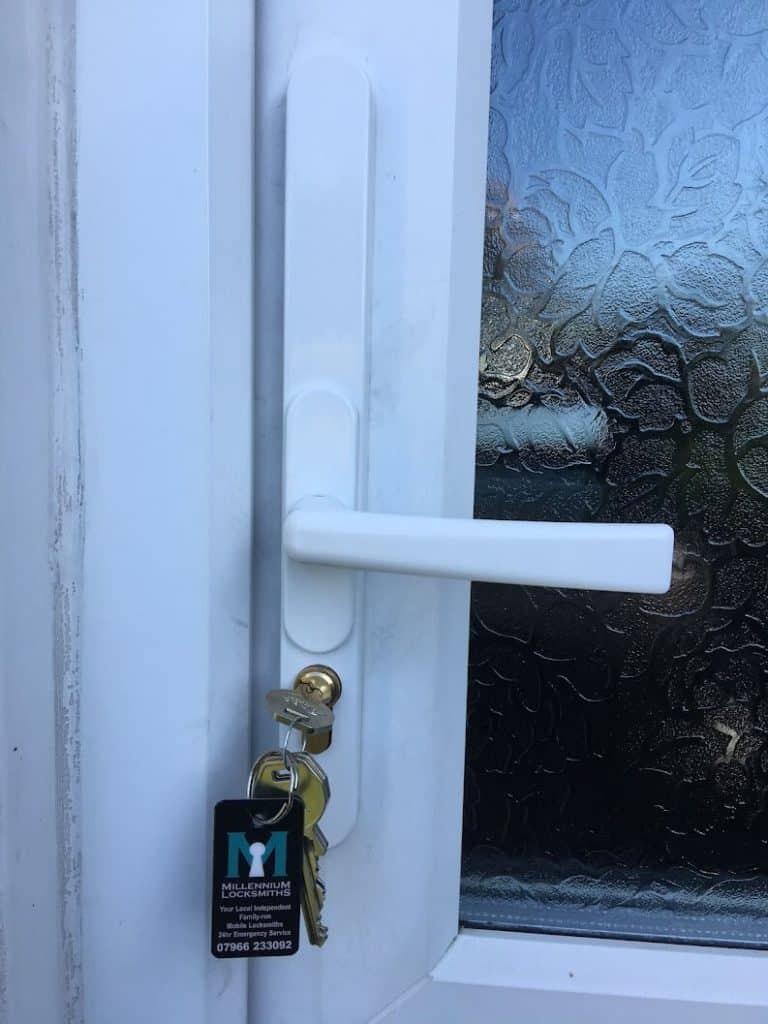A faulty door lock is one of the most frustrating things to deal with as a homeowner. Whether it’s a sticky lock that won’t turn or a key that just won’t fit, dealing with common door lock problems can be a headache. In this blog post, we will discuss some of the most common door lock issues homeowners face and provide tips on resolving them.
Table of Contents
Key Doesn’t Fit Properly
One of the most common problems homeowners face with door locks is when their keys don’t fit properly. A worn-out key or an improperly aligned lock mechanism are just two potential causes. To resolve this problem, use graphite lubricant on the key and insert it into the lock several times to see if it helps. If the problem persists, you may call a locksmith to rekey or replace your lock.
The first step in fixing a key that doesn’t fit properly in the lock is using graphite lubricant. Graphite lubricant is designed for locks and can help smooth out any rough spots or debris causing the issue. Apply a small amount to your key and insert it into the lock several times to see if it improves the fit.
If using graphite lubricant doesn’t solve the problem, the next step is to inspect both your key and lock for visible signs of damage or wear. A worn-out key or a misaligned lock mechanism could be causing the issue. You may need to call a locksmith to rekey or replace your lock if you notice any damage. A professional locksmith will have the expertise and tools to assess the situation and recommend the best solution.
Sticky Lock
Have you ever encountered a sticky lock that is difficult to turn? The lock mechanism frequently develops this problem due to dirt, debris, or wear and tear. To fix this, spray WD-40 or silicone lubricant into the keyhole, and then operate the lock several times to distribute the lubricant evenly. If the issue persists, you may need to disassemble the lock for a thorough cleaning or replacement.
If using lubricant doesn’t work, you might need to disassemble the lock mechanism for a thorough cleaning. This process requires attention to detail and essential tools like screwdrivers and cotton swabs. Start by removing the lock’s faceplate, then carefully disassemble each component while noting their positions for reassembly later. Use a mild solvent or cleaner to remove dirt or debris inside the mechanism before drying it with a clean cloth.
Sometimes, a sticky lock may be beyond repair due to extensive wear and tear or damage to internal components. If cleaning and lubricating don’t improve its function, you might need to replace the lock mechanism. A qualified locksmith with the tools and skills required for the proper installation should handle this task. Investing in a high-quality replacement lock can provide added security and peace of mind, knowing your property is well-protected.
Loose Doorknob
A loose doorknob can make opening and closing your door difficult. This issue can be due to loose screws holding the knob in place or internal components that have worn out over time. To fix this problem, start by tightening any loose screws on the doorknob with a screwdriver and checking for any visible damage to internal components. If tightening the screws doesn’t work, you may need to replace the entire door knob assembly.
The first step in addressing a loose door knob is identifying the cause of the problem. Loose screws holding the knob in place are a common reason. To fix this, use a screwdriver to tighten any loose screws on the door knob. Make sure to check all the screws on both sides of the door to ensure they are secure.
If tightening the screws doesn’t resolve the issue, the problem may be with worn-out internal components. To check for this, remove the door knob by unscrewing it from both sides of the door. Inspect the internal components for any visible damage or wear and tear. If you notice any damaged parts, you may need to replace them with new ones.
Deadbolt Doesn’t Extend Fully
If the deadbolt on your door doesn’t fully extend into its strike plate, your home may not be as secure as you think. A misaligned strike plate or worn-out deadbolt components may be the root of this problem. To fix this problem, first, check if the strike plate aligns appropriately with the deadbolt and adjust it if necessary. If this doesn’t work, you may need to replace the deadbolt or the strike plate.
To check if the deadbolt is aligned correctly with its strike plate, close the door and engage the deadbolt. If there’s a visible gap between the edge of the door and the strike plate, the deadbolt isn’t fully extending into it. You might also notice that the deadbolt doesn’t turn smoothly or securely when locking and unlocking it.
If you find that your deadbolt isn’t fully extending into its strike plate, you may need to adjust the position of the strike plate. Use a screwdriver to loosen the screws holding the strike plate in place, and then shift it up or down so that it aligns with the deadbolt. Once you’ve made the necessary adjustments, tighten the screws back in place.
If adjusting the strike plate doesn’t solve the problem, you may need to consider replacing either the deadbolt or the strike plate entirely. Look for signs of wear and tear on both components, such as rust, corrosion, or visible damage. Investing in high-quality replacement parts can help ensure long-lasting security for your home.
Frozen Lock
In cold climates, homeowners may encounter frozen locks during the winter. This can happen when moisture gets inside the locking mechanism and freezes overnight, making it impossible to unlock your door without damaging your key or lock mechanism. To prevent frozen locks, consider installing a de-icer spray for your locks before winter sets in, or use a hair dryer on low heat to thaw out frozen locks safely.
One of the best ways to prevent frozen locks is to use a de-icer spray specifically designed for locks. These sprays are readily available at hardware stores and are easy to use. Spray the de-icer into the keyhole and around the lock mechanism before winter sets in. This will help displace any moisture that could freeze and cause your lock to become stuck. It’s a simple preventative measure that can save you time and frustration during the colder months.
Another effective method for preventing frozen locks is using a silicone-based lubricant on your locks before winter arrives. This lubricant will help repel water and moisture, reducing the likelihood of your lock freezing. Be sure to choose a lubricant that is safe for use on locks and won’t attract dirt or debris over time. Applying this lubricant periodically throughout the winter can help keep your locks functioning smoothly.
If your lock freezes, do not force it open with excessive pressure, which can damage your key or lock mechanism. Instead, try using a low-heat hairdryer to thaw out the frozen lock. Hold the hairdryer several inches away from the lock and move it back and forth until the ice has melted enough for you to insert your key and unlock the door. This method is safer than hot water or brute force, as both can cause damage.
Dealing with common door lock problems can be frustrating for homeowners, but knowing how to troubleshoot these issues can save you time and money in the long run. By following some simple tips, like using lubricant on sticky locks or tightening screws on loose knobs, you can keep your doors secure and functioning correctly. And remember, if all else fails, don’t hesitate to call a professional locksmith for help resolving more complex door lock problems.
Looking for locksmiths Hemel Hempstead and surrounding areas? Contact Millennium Locksmiths today for free locksmith quotes.








